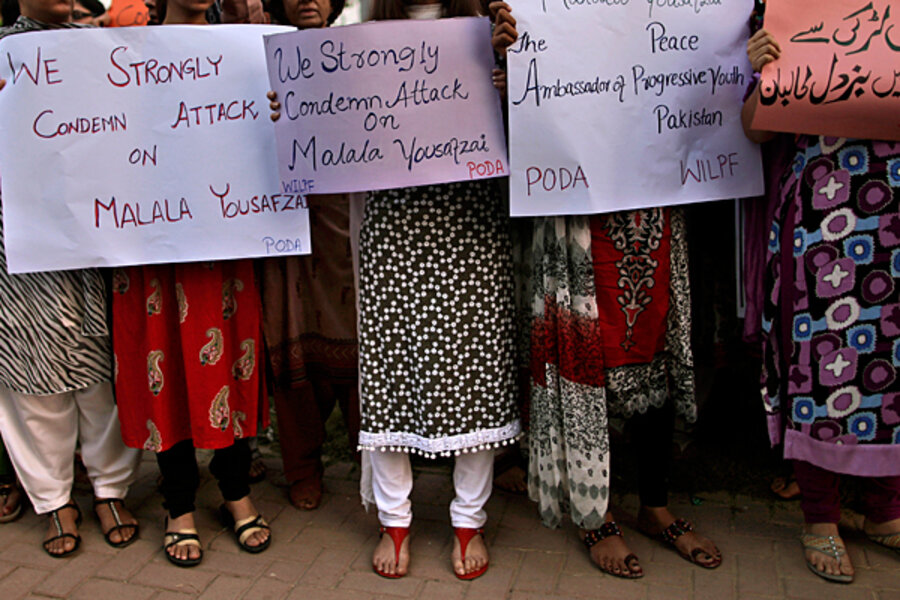Taliban shooting of 14-year old sparks outrage in Pakistan
Loading...
| Lahore, Pakistan
Political leaders and media have joined students, activists, and a broad segment of Pakistanis in condemning the Pakistani Taliban for shooting a 14-year-old girl in the head and neck, leaving her in critical condition this week.
The girl, Malala Yousafzai, is a children's rights activist who blogged about life under the Taliban also known as Tehrik-i-Taliban Pakistan (TTP) when it occupied her home district of Swat in 2009. She is known for her media appearances bringing attention to atrocities carried out by the militant group.
The shooting prompted widespread outrage against the Pakistani Taliban and Islamist militancy among ordinary Pakistanis – and some hope that the strong reaction would prompt some type of change. Though officials have offered a 10 million rupee ($105,000) reward for information leading to the arrest of the girl's assailants, human rights activists, however, remain skeptical.
“This is not the first time that extremist militant groups have carried out atrocities. I am pleased to see the strong reaction, but fear that little will change,” says I. A. Rehman, the Secretary-General of the Human Rights Commission of Pakistan.
A TTP gunman sought out Malala on a school bus on Tuesday and shot her twice. Two other girls sustained injuries, and one was in critical condition on Wednesday. Malala is now “out of danger,” according to surgeons who have successfully removed both bullets.
But Ehsanullah Ehsan, the TTP Spokesman who claimed responsibility for the shooting, says that the militant group would attack her again if she survives.
“She was pro-West, she was speaking against the Taliban and she was calling President Obama her idol,” he said in a statement. “She was young but she was promoting Western culture in Pashtun areas.” Malala and her father, Ziauddin Yousafzai, have been on a TTP hit list since 2011.
Politicians respond
Politicians from across the political divide reacted strongly and immediately to the TTP attack on Twitter.
“The attack on Malala Yousaf Zai is deplorable, and I strongly condemn this act. I hope that she will recover soon inshaALLAH,” wrote Syed Munawwar Hassan, the leader of the Islamist Jamaat-e-Islami party in a tweet.
“Malala is the daughter of our nation and if she is not safe then no child is safe in this country,” said the Pakistani Prime Minister Raja Pervaiz Ashraf in a speech before the Senate earlier today.
Cricketer-turned-politician, Imran Khan, who recently led a march against drone attacks in Pakistan's tribal areas, has also condemned the shooting, calling it a “cowardly attack” by “brutal terrorists.” He has offered to take on all expenses for any medical treatment or travel that Malala or her family require.
Chief of Army Staff Gen. Ashfaq Parvez Kayani visited Malala at the hospital and described the attack on Malala “heinous” and said it exposed an “extremist mindset” in Pakistan – the Pakistani Taliban has also beheaded Pakistani soldiers and threatened attacks on the military.
Back in Swat
Schools in Swat closed in protest against the killing. Some 200 people from Pakistan’s civil society showed up at a vigil in front of Lahore Press Club in Pakistan's cultural capital. Hundreds also gathered for protests across the country – including Pakistan's political and commercial capitals, Karachi and Islamabad.
The Pakistani Taliban gained significant control of Swat, once known for its peaceful ski resorts and vacations spots for Islamabad’s elite, in 2006 and occupied it from March to May 2009: the same period that Malala wrote a blog under a pseudonym for BBC Urdu.
The Pakistani military pushed out the TTP from Swat during an operation in May 2009 that killed 1,200 Taliban fighters and 90 Pakistani soldiers, according to the Pakistan Army. The operation was declared a success by the Army, and it’s still under the Army control, though that hasn’t stopped such attacks from happening.
Where is the way forward?
Pakistan continues to debate whether the acts of violence by Islamist militants require a political or a military solution. Mr. Khan advocates political negotiations, arguing that military approaches only increases militancy.
However, the TTP is widely considered to be splintered after a 2009 drone attack killed its leader, Baitullah Mehsud, in the Zangar area of South Waziristan, prompting a leadership crisis. The group’s divisions and splintering makes it more difficult to identify central leadership or cells.
Security analyst Ayesha Siddiqa questions the notion that the splinters make too much of a difference: "All these Islamist groups are inter-related. You cannot see the TTP separately from, for example, the Haqqani network, which we all know has links to the Pakistani Army. If our security forces are serious about dealing with the TTP they need to deal with all of these groups, and in a holistic manner,” says Ms. Siddiqa.
“For everyone who seems to think Malala's assassination attempt is some 'moment' – Pakistan had lots of them and guess what happened? Nothing,” tweeted journalist at Pakistan's Express Tribune, Saba Imtiaz, in reaction to a raging debate on Pakistan's social media after the news of Malala's shooting reached the rest of the country.







